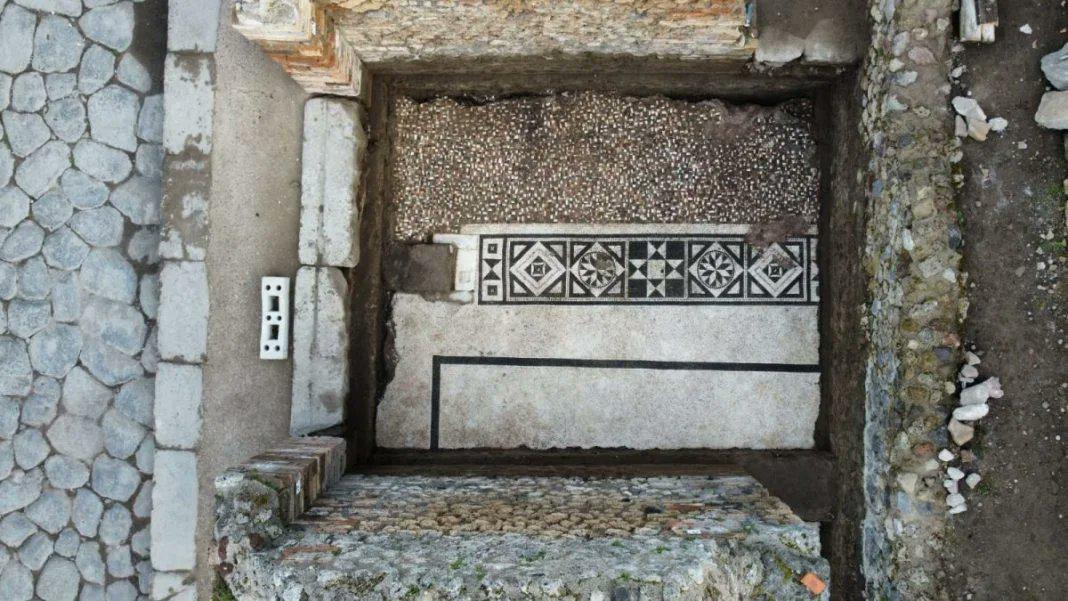Archaeologists have uncovered a section of mosaic flooring in Roman Pompeii that was abandoned following earthquake of 62 AD. Pompeii was a Roman city, located in the modern commune of Pompeii near Naples in the Campania region of Italy. Pompeii, along with the Roman town of Herculaneum were buried under 4 to 6 metres of volcanic ash and pumice during the eruption of Mount Vesuvius in AD 79. In AD 62, region was struck by an earthquake that had a magnitude of V to VI on the Mercalli scale. The maximum felt intensity is estimated to have been in the range of IX to X, resulting in severe damage to buildings in Pompeii and the surrounding region. A Bas-relief found in the lararium of the House of Lucius Caecilius Iucundus depicts the events, showing damage to the city and Pompeii’s Temple of Jupiter. Recent excavations involving archaeologists from the Archaeological Park of Pompeii, the Freie Universität Berlin, and the University of Naples L’Orientale, have revealed a section of mosaic flooring off via dell’Abbondanza, the main street (decumanus maximus) which passed through the city. The mosaic is part of the flooring of a domestic domus, where the Stabian Baths would later be constructed in 2nd Century AD. The domus was flattened in the years following the earthquake and the area was converted for part of the bath complex and several shops. The team were excavating in the western part of the bath complex in an area known as 3 tabernae, a corridor behind natatio (swimming pool) the that leads onto the vicolo del Lupanare. Below the 79 AD, floor level of the corridor, archaeologists found the remains of a white mosaic bordered by a black band with a central polychrome emblem featuring a geometric pattern. The pattern was made with black, white and green tesserae, bordered by a double red and black band which is a similar design to the opus sectile floors of the cella of the temple of Apollo, the tablinum of the house of the Faun, and an exedra found in the house of Triptolemus at Pompeii. Gabriel Zuchtriegel, Director the project, said: “Thanks to new research by the University of Berlin and the University of Naples, today we can begin to rewrite the history of the block, inserting a further chapter, that of a sumptuous domus with exceptional mosaics and spacious rooms, which occupied the western part of the baths area until a few decades before the eruption in AD 79.” © Mark Milligan #archaeohistories.
Get updates delivered to you daily. Free and customizable.
David McKay
Comments / 0
Add a Comment
YOU MAY ALSO LIKE
 Most Popular
Most PopularCooking With Maryann10 hours ago
The Current GA21 days ago
Chicago, IL14 hours ago
Herbie J Pilato26 days ago
J. Souza16 days ago
Los Angeles, CA4 days ago
Cooking With Maryann12 hours ago
WyoFile25 days ago
Massachusetts State25 days ago
Cooking With Maryann2 days ago
Declutterbuzz5 days ago
J. Souza8 days ago
Massachusetts State12 days ago
Get updates delivered to you daily. Free and customizable.
It’s essential to note our commitment to transparency:
Our Terms of Use acknowledge that our services may not always be error-free, and our Community Standards emphasize our discretion in enforcing policies. As a platform hosting over 100,000 pieces of content published daily, we cannot pre-vet content, but we strive to foster a dynamic environment for free expression and robust discourse through safety guardrails of human and AI moderation.


Comments / 0